 полная версия
полная версияField Book of Western Wild Flowers
California Buckeye
Aésculus Califórnica
White
Spring, summer
California
One of our handsomest western shrubs, usually from ten to fifteen feet tall, with gray bark, and dark bluish-green foliage, the leaflets from five to seven in number, glossy on the upper side, pale and dull on the under, and firm in texture. The flowers have a rather heavy scent and are about an inch across, with four or five, slightly irregular, white petals, which become pink in fading, a pinkish ovary and long stamens with curling, white filaments, unequal in length, with buff anthers. They are crowded in a magnificent, pyramidal cluster, about a foot long, which has a pinkish-red, downy stem, and the buds are also downy and pinkish, so that the color effect is warm-pink above, merging into cream-white below, the whole made feathery by the long stamens. The shrub has a rounded top of rich green foliage, symmetrically ornamented with spires of bloom, standing up quite stiffly all over it. The large, leathery pod contains a big, golden-brown nut, supposed to be poisonous to cattle. The leaves fall off very early in the season, leaving the pods hanging on the bare branches. This is at its best in the mountain valleys of middle California, sometimes becoming a good-sized tree.
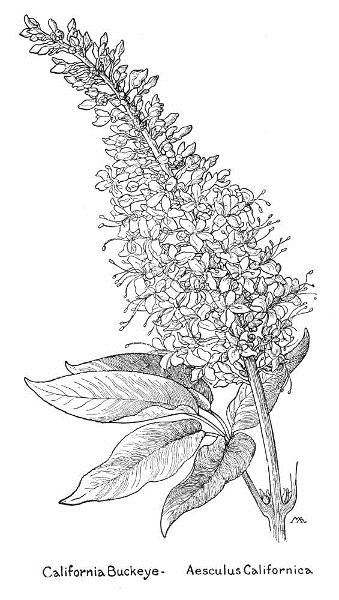
California Buckeye – Aesculus Californica.
BUCKTHORN FAMILY. Rhamnaceae
A large family; shrubs, or small trees, of temperate and warm regions, some with bitter, astringent properties, often thorny; leaves mostly alternate; stipules minute; flowers often in showy clusters, small, regular; calyx-lobes and stamens four or five; petals usually four or five, sometimes lacking, with claws. The short calyx-tube is lined with a fleshy disk and on this are borne the petals and the stamens, alternate with the sepals and opposite the petals, with swinging anthers. In some cases, some of the flowers have only pistils or only stamens. The ovary superior or partly inferior; the fruit a berry or capsule.
There are many kinds of Ceanothus, largely western; flowers small, blue or white, in clusters; calyx bell-shaped, five-lobed, with a colored, petal-like border; petals five, the tips arching to form a tiny hood, with long claws; stamens five, long, protruding, with threadlike filaments; ovary partly inferior; style three-cleft; capsule splitting open elastically so as to scatter the three, hard nutlets. The flowers make a soapy lather when rubbed in water, hence the name Soap-bush, and the kinds with rigid branches are called Buckbrush. Red-root is another name. Mountain Lilac is the commonest name, but misleading. Lilacs belong to another family.
Squaw Carpets, Mahala Mats
Ceanòthus prostràtus
Blue
Spring, summer
Cal., Oreg.
This decorative shrub is common in the Sierras and carpets the forest floor with a rich green, leafy mat, sprinkled with small, feathery clusters of blue flowers. The trailing stems are clothed with leathery leaves, opposite and very glossy, and the little flowers are deep purplish-blue, with yellow stamens, and slightly scented. These plants are equally attractive late in the season when the flowers are replaced by scarlet seed-vessels, with three horns.
Snow Brush, Mountain Lilac
Ceanòthus velùtinus
White
West, except Ariz.
A fine shrub, two to twelve feet high, with stout trunk and branches, easily recognized by its leaves, which are rich green, thick and resinous, shiny as if varnished on the upper side and sometimes rich chocolate-brown in color, but pale on the under side, with three, conspicuous nerves. The small, sweet-scented flowers are crowded in compact, creamy clusters, sometimes four or five inches long, very handsome, but not so delicate as Deer-brush. This is common on hillsides and in the mountains, up to seven thousand feet.
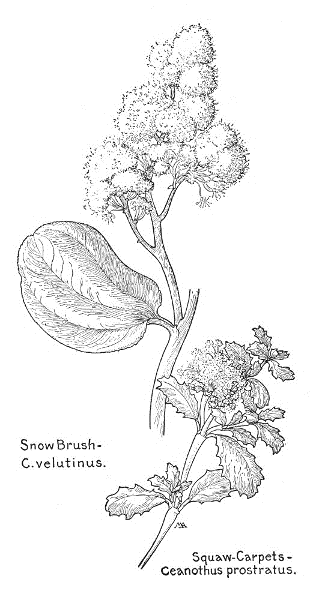
Snow Brush – C. velutinus.
Squaw-Carpets – Ceanothus prostratus.
Deer-brush, Mountain Lilac
Ceanòthus integérrimus
White, blue
Summer
Cal., Oreg., Wash., Ariz.
A graceful shrub, or small tree, six to fifteen feet tall, the slender trunk and branches covered with dull yellowish-green bark and the bright green foliage setting off the feathery flower clusters, two to six inches long, scattered lightly over the bush and composed of innumerable, tiny, sweet-scented blossoms. The leaves are alternate, half an inch to three inches long, toothless, thin in texture, very slightly downy or smooth, with three veins, and the flowers cream-white, occasionally blue or pink, with conspicuous stamens, which give the plume-like sprays a delicate foamy effect against the dark forest background. This shrub is a beautiful sight when in flower and sometimes covers the mountainsides with drifts of snowy bloom, filling the air with delicate perfume. It is quite variable and sometimes has dark shiny leaves and small compact clusters of flowers. It is often called White Tea-tree, because the bark is used medicinally.
Blue Mountain Lilac
Ceanòthus parvifòlius
Blue
Summer
California
An attractive mountain shrub, growing in Yosemite, and elsewhere in the Sierra Nevada Mountains at similar altitudes, low and spreading, about three feet high, with smooth, pale green branches and small, smooth, toothless leaves, dark green and shining on the upper side, pale on the under. The oblong clusters of minute blue flowers are slightly sweet-scented and about two inches long.
MALLOW FAMILY. Malvaceae
A large family, widely distributed; mostly herbs, with mucilaginous juice and tough, fibrous bark; leaves alternate, mostly palmately-veined and lobed, with stipules; flowers regular, perfect, or the stamens and pistils on different plants; sepals five, often with an outer row of bracts below, resembling another calyx; petals five, their bases or claws united with each other and with the base of the stamen-tube; stamens numerous, united by their filaments into a column, forming a tube enclosing the pistils; fruit a capsule, breaking when ripe into several one-seeded parts, or splitting down the back of the valves, allowing the seeds to escape. The little fruits are commonly called "cheeses." True Mallows are introduced "weeds" in this country.
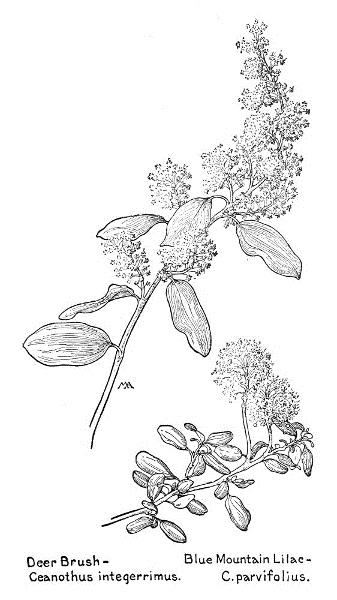
Deer Brush – Ceanothus integerrimus.
Blue Mountain Lilac – C. parvifolius.
Arizona Wild Cotton
Thurbéria thespesioìdes (Ingenhouzia triloba)
White
Summer
Arizona
The only kind, a fine shrub, from four to eight feet high, with smooth leaves, most of them with three lobes, and handsome cream-white flowers, tinged with pink on the outside and measuring two inches across. This grows in the mountains of southern Arizona and is beautiful under cultivation, often growing to a height of six or eight feet in a season.
There are a number of kinds of Sidalcea, difficult to distinguish; perennials; leaves round in general outline, variously cut and lobed; flowers showy, in terminal clusters; calyx with no outer bracts, or with only one; stamen-column double; stigmas threadlike, distinguishing them from Malvastrum and Sidalcea.
Rose Mallow
Sidálcea Califórnica
Pink
Spring
California
This has velvety leaves, those from the root much less deeply lobed than the others, and a slender, slightly hairy stalk, one to two feet tall, leaning to one side and bearing a loose raceme of rose-pink flowers, with petals about an inch long. Only one or two flowers are open at a time, but they are very pretty and conspicuous in open woods and along the edges of fields, around Santa Barbara, in May.
Oregon Mallow
Sidálcea Oregàna
Pink
Summer, autumn
Northwest
A pretty plant, with one or more smooth, pale, branching stems, about two feet tall, and dark green leaves, with conspicuous veins. The buds are downy and the flowers are about three-quarters of an inch across, with pale pink petals, prettily veined, shading to white at the center. The anthers are white and the pistil, when the stigmas have expanded, is prettily tipped with a tiny crimson brush.
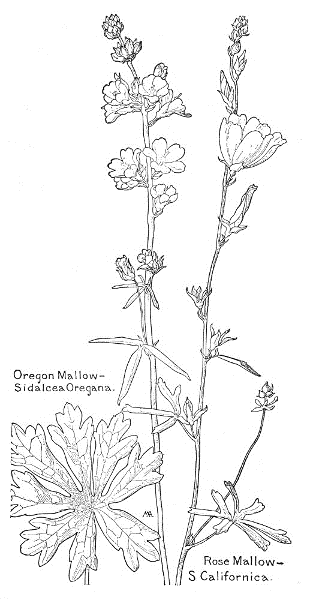
Oregon Mallow – Sidalcea Oregana.
Rose Mallow – S. Californica.

Checker-bloom
Sidálcea malvaeflòra
Pink
Spring
California
A pretty perennial, with several leaning, hairy stems, one or two feet tall, and dark green leaves. Some plants have perfect flowers, an inch or more across, often very pale pink, and others have only rudimentary stamens and smaller flowers, usually deep pink in color, but the plant is very variable. This is common near the coast. It is sometimes called Wild Hollyhock.
Mallow
Sidálcea Neo-Mexicàna
Pink
Summer
Ariz., Utah, New Mex., Col., Wyo.
This is from one to three feet tall, with smooth, rather dark green leaves and very pretty, pale purplish-pink flowers with pale-yellow anthers and pinkish pistil. This grows in the mountains.
There are many kinds of Malvastrum, natives of America and Africa; perennial herbs or shrubs; the calyx often with three outer bracts; the stamen-column bearing anthers at the top; the stigmas with round heads. The name is from the Greek, meaning "star-mallow."
Spotted Mallow
Malvástrum rotundifòlium
Pink
Spring
Southwest
A very pretty desert plant, from six to eight inches tall, the coloring of the flowers, stems, and leaves vivid and oddly contrasting, for the stems are bright red and hairy, and the leaves stiff, hairy, and bronze-green in color, while the lovely globe-shaped flowers, which are over an inch across, are delicately shaded from lilac to rose outside and paler inside, with conspicuous round blotches of orange-vermilion at the base of each petal within. The calyx and buds are very hairy, the petals each have a twist to one side, and the mauve stamens form a pretty cluster in the center. These flowers last a long time in water, closing at night and opening again in the morning.

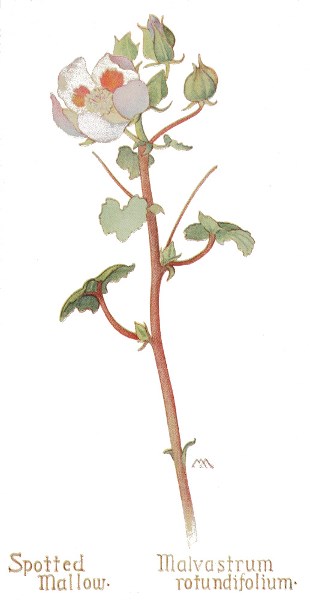
Spotted Mallow – Malvastrum rotundifolium.
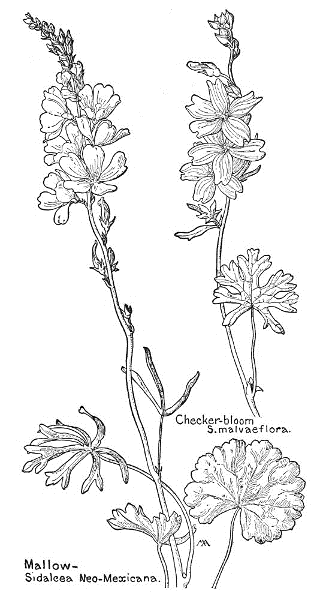
Checker-bloom – S. malvaeflora.
Mallow – Sidalcea Neo-Mexicana.
False Mallow
Malvástrum Thúrberi
Pink
Spring, summer
California
A handsome shrub, from five to ten feet high, woody below, with long, slender, wandlike branches and thick, very downy, light bluish-green leaves. The pretty lilac-pink flowers are from one to nearly two inches across and pleasantly scented, and the foliage is soft and pretty in appearance, though rather harsh to the touch, its pale tones blending harmoniously with the delicate blossoms. This is common in southern California.
There are several kinds of Lavatera, mostly from the Old World.
Tree Mallow
Lavàtera assurgentiflòra
Pink
Spring
California
This was planted in the mission gardens by the Fathers and is now common around San Francisco. It is a branching shrub, from six to fifteen feet high, with a twisted, gray trunk and large handsome leaves, light green and very soft and smooth to the touch, paler and downier on the under side. The flowers are handsome and conspicuous, two or three inches across, with bright pink petals, warm and rich in tone, beautifully striped with maroon and shading to yellowish-white towards the center, with a purple pistil and grayish anthers. The flowers and seed-vessels hang on curved pedicels, like pipe-stems, giving a rather odd effect. The leaves and twigs are very mucilaginous.
There are many kinds of Sphaeralcea, much like Malvastrum, except that they have two or three ovules, instead of one, in each cavity of the ovary. The name is from the Greek, meaning "globe-mallow," in allusion to the usually roundish fruit.
Scarlet Mallow
Sphaerálcea pedàta
Red
Spring
Southwest
These graceful wands of brilliant bloom are very common in spring in Arizona. The flowers are over an inch across, vivid yet delicate in color, shading from luminous scarlet to clear pale-orange. The buds are tipped with deeper red and the foliage is rather pale green, somewhat hairy and downy. The stems are from one to two feet tall and bend slightly to one side, swaying to and fro in the wind and displaying their flaming blossoms to great advantage.
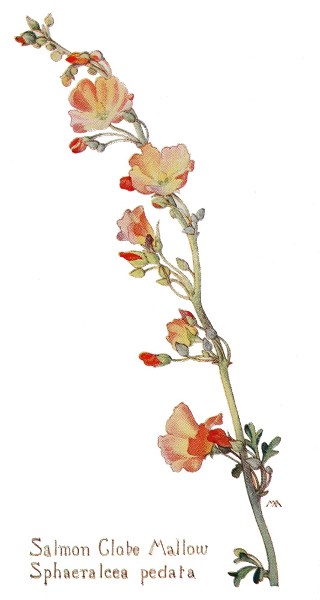
Salmon Globe Mallow – Sphaeralcea pedata.
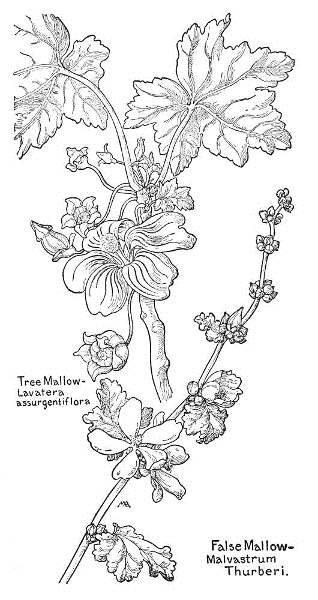
Tree Mallow – Lavatera assurgentiflora.
False Mallow – Malvastrum Thurberi.
ST. JOHN'S-WORT FAMILY. Hypericaceae
Not a large family, mostly natives of temperate and warm regions. Ours are herbs, sometimes shrubby, without stipules, with opposite, toothless leaves, with clear or black dots; the flowers regular and complete, all the parts borne on the receptacle; the sepals and petals usually five; the stamens usually numerous, sometimes grouped in three to five clusters; the ovary superior; the fruit a capsule.
There are many kinds of Hypericum, widely distributed; the leaves without leaf-stalks, the flowers yellow, with three to six styles. This is the ancient Greek name. These plants bloom in June, about St. John's Day, and so tradition gives them magic properties, appropriate to the Eve of that day, when fairies and witches are abroad, and they are commonly called St. John's-wort.
St. John's-wort
Hypéricum concínnum
Yellow
Summer
California
This has very pretty flowers and grows from three to eighteen inches tall, with smooth stems, branching and woody at base, and smooth, rather bluish-green leaves, usually folded, not clasping at base, usually with only a few dots. The flowers are an inch or more across, with bright golden petals, with some black dots, and numerous stamens in three bunches, forming large, fuzzy, golden centers. This grows on dry hills and is supposed to be poisonous to sheep.
St. John's-wort
Hypéricum formòsum var. Scoúleri
Yellow
Summer
West
A pretty plant, from six inches to three feet tall, with a stiff stem, often branching towards the top, and rather dull green leaves, blunt, oblong and clasping at base, about an inch long, thin in texture, with black dots on the margins. The flowers are from half an inch to an inch across, with bright yellow petals, dotted with black, and are very pretty, but not so handsome as the last. This grows in moist places, chiefly in the mountains, and is common in Yosemite.
Creeping St. John's-wort
Hypéricum anagalloìdes
Orange
Summer
Northwest
An attractive little plant, only a few inches tall, with many weak, slender, branching stems, spreading on the ground and rooting at the joints, and small, smooth, light yellowish-green leaves, often tinged with red. It grows in wet places and forms close mats of foliage, sprinkled with light-orange or salmon-colored flowers, a quarter of an inch or more across, with fifteen to twenty, yellow stamens. The effect is something like Anagallis, Scarlet Pimpernel, hence the name. This is common in Yosemite and similar places, up to nine thousand feet.
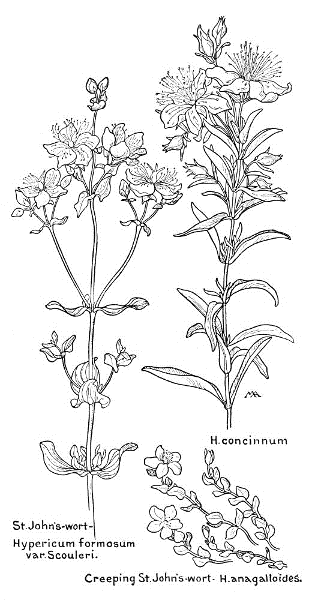
H. concinnum.
St. John's-wort – Hypericum formosum var. Scouleri.
Creeping St. John's-wort – H. anagalloides.
FOUQUIERA FAMILY. Fouquieriaceae
A very small family, with one genus and only a few species; natives of the Southwest and Mexico; the flowers are brilliant red, in terminal clusters; the sepals five, not united; the petals five, united into a tube, the lobes somewhat spreading; the stamens ten to fifteen, protruding, inserted under the pistil; the ovary imperfectly three-celled; the styles three, long, somewhat united; the seeds three to six, oblong, flattened, surrounded by a membranous wing or long, white hairs. These plants are very puzzling, but interesting, and as they are not nearly related they have at various times been classified with other families.
Flaming Sword, Ocotillo, Candle Flower
Fouquièra spléndens
Red
Spring
Ariz., Cal., New Mex.
A magnificent desert shrub, when in full bloom, but strangely forbidding in aspect in spite of its beauty. Its many stiff stems, from six to twenty feet tall, entirely without branches, stand up stiffly from the root, like a bunch of wands, and are armed their whole length with terrible thorns, which in the spring are masked with beautiful foliage, like little apple leaves. From the tip of each wand springs a glorious cluster, from six to ten inches long, composed of hundreds of scarlet flowers, each about an inch long, and crowded closely together, suggesting a flame and waving to and fro in the wind with a startling effect against the pale desert sand. When the flowers and leaves are gone, the clumps of dry, thorny sticks look quite dead and it is hard to believe that they were so splendid early in the season. They make an impenetrable fence and are much used by the Indians for hedges.
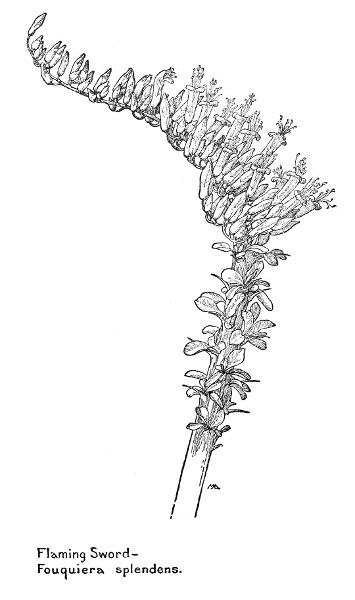
Flaming Sword – Fouquiera splendens.
VIOLET FAMILY. Violaceae
A rather large family, widely distributed, but we have only three genera, the principal one being Viola, which is the ancient Latin name, used by Virgil.
There are many kinds of Viola, widely distributed, blooming in spring, but often flowering again in the autumn; low, perennial herbs, with stipules; leaves alternate, or from the root; flowers complete, irregular, nodding, nectar-yielding, usually single; sepals five, with small ear-shaped projections at the base; petals five, slightly bearded within, so as to afford a foothold for bees, the lowest petal larger and with a spur at the back; stamens five, short, with broadened filaments and anthers opening inward, so as to cover the pistil all but the end of the style, the two lower anthers with spurs at the base, which project into the spur of the petal; ovary superior and one-celled; style club-shaped, with a one-sided stigma. The flowers are often of two kinds, the earlier ones with long flower-stalks, with petals and showy, but not producing seed; the later ones with short stalks, with small or no petals, but fertile, often cleistogamous, that is, fertilized in the bud. The capsule splits open and as the three valves dry they fold firmly together lengthwise and force out the seeds.
Pine Violet
Vìola lobàta
Yellow
Spring, summer
Cal., Oreg.
A pretty plant, growing in the woods, with leafy stems, from four to fourteen inches high, with leafy stipules and smooth, rather light green leaves, deeply lobed, so that they look unlike most Violet leaves. The flowers are more or less clustered, an inch or more across, with bright yellow petals, veined with purple inside, tinged with purplish-brown outside, the two side petals with a little hairy patch at the base inside.
Western Heartsease
Vìola ocellàta
White and yellow
Spring, summer
Cal., Oreg.
A shy little woodland plant, from five to twelve inches tall, with creeping rootstocks and small, dry stipules. The flowers are an inch or less across, the two upper petals white, tinged with reddish-purple on the outside, and the other petals white or yellow, with a splash of purple on each of the two side petals and the lower one veined with purple. This grows in shady woods.
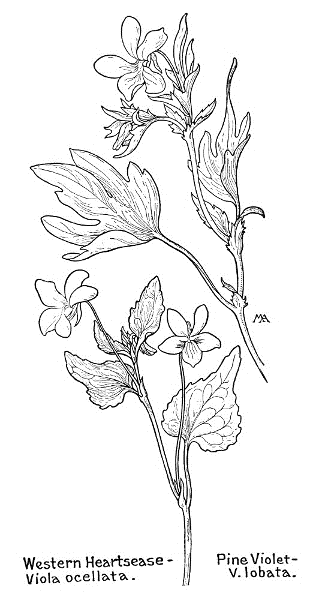
Western Heartsease – Viola ocellata.
Pine Violet – V. lobata.
Yellow Mountain Violet
Vìola venòsa
Yellow
Spring
Northwest and Utah
An attractive kind, usually about three inches tall, with almost smooth leaves, often with purplish veins, with blunt tips and margins obscurely or coarsely toothed, or almost toothless, and with long leafstalks. The flowers are usually less than half an inch long, with clear yellow petals, more or less tinged with purple on the outside, the lower petal usually with several, purplish-black veins, the two side petals with one or two veins. This has no scent, the capsule is roundish and hairy, and the cleistogamous flowers are abundant. It grows on dry mountainsides and is very variable both as to flower and foliage and much smaller at great altitudes, the whole plant being not more than an inch high. The drawing is of a Utah plant.
Canada Violet
Vìola Canadénsis
Pale-violet, white
Spring, summer
West, etc., except Cal.
This is quite tall, the slender, rather weak stems being sometimes over a foot high, with smooth leaves, often with some hairs on the veins of the under side. The flowers, over half an inch across, with a short petal-spur, are almost white, delicately veined with purple, yellow in the throat and tinged with violet or purple on the outside. Occasionally they are pure-white all over and sometimes sweet-scented. The capsule is oval and smooth. This is common in eastern mountain woods, and to eastern eyes looked far from home when we found it in Walnut Canyon in Arizona.
Pale Mountain Violet
Vìola adúnca var. glàbra
Pale-blue
Spring, summer
Utah
This is small and low, about three inches high, with leafy stems, forming a clump of small, smooth, more or less toothed leaves, with blunt tips, dark green on the upper side and paler on the under, with two, quite large, fringed bracts at the bases of the leaf-stalks, and two, small, fringed bracts on the flower-stems, half an inch below the flower. The flowers are scentless, measure less than half an inch across, and are pale-blue or almost white, with veins of dark blue on the lower petal and tufts of white, fuzzy hairs inside, at the base of the side petals, the spur purplish. This grows in mountain canyons, at a height of five thousand to nine thousand feet, and is very small at great altitudes.

